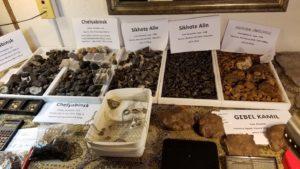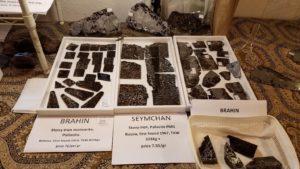Top photo: NASA
Story and photos by Emmalee Mauldin/Arizona Sonora News
Imagine being flown out into the middle of the Russian wilderness by helicopter. The helicopter drops you off with rations and supplies to last you a few weeks, which you’ll carry around with you. There is no Wi-Fi, no television, no bathing except in the frigid river water – and no civilization in sight. You won’t leave the wilderness until you find what you’d heard rumors about: a meteorite. This is the reality for Boris Aleksejevs, a young meteorite hunter from Russia.
Aleksejevs and other determined meteorite hunters travel around the world, adventuring into the most remote places in order to find meteorites, which are fragments of meteors that enter Earth’s atmosphere and fall to the ground. They can land anywhere on the planet, and range in size from the smallest dust speck to the size of a car (or far larger, as in the case of famous craters made by meteors like the mile-wide, 550-foot-deep Meteor Crater, a global tourist attraction in the Arizona desert about 40 miles east of Flagstaff).
Competition for finding these objects from the skies is robust. “It’s getting harder to find meteorites,” Aleksejevs said. “There’s so many people now.”
Stories like Aleksejevs’s trek into the wilds and the quest for meteorites are common amongst meteorite hunters from around the world.
Dozens of meteorite hunters and vendors converged in Tucson for the Tucson Gem and Mineral Show. It started on Jan. 31 and ends on Feb. 17, although most of the meteorite vendors were selling their wares from Feb. 2 to 5.
The vendors come from all around the world – Russia, Bulgaria, India, Czech Republic, Great Britain and a few from the United States. Some of them have been attending the Gem Show for years. They have established their “usual spot” in room 307, 134 or 322 at the Hotel Tucson City Center or Days Inn locations for the Gem Show. The City Center location is considered the main hub for meteorite vendors, but they can also be found in other locations, like the Days Inn.
There are three main types of meteorites: iron, stony and stony-iron. Iron meteorites are dense rocks, composed mostly of nickel and iron, that formed in the core of a planet and was ejected during a collision. Stony meteorites are remnants of our solar system’s formation, mini capsules that are valuable in research because they may hold keys to how life originated on Earth. Stony-iron meteorites are a combination of iron and stony meteorites that likely form when a stony and iron meteorite collide.
“Almost all meteorites come from the asteroid belt,” said Vyacheslav, a Russian meteorite hunter who declined to give his surname. The asteroid belt is a ring between Mars and Jupiter that contains millions of asteroids, which are small bodies of rock (although they can reach the size of a small planet). Vyacheslav said that most meteorites that come from the asteroid belt are around 4.5 billion years old.
Vyacheslav hunts for meteorites the old-fashioned way: with a metal detector out in the middle of an area where previous meteorites have been found. Meteorites are often found in the same region because they were likely one large meteor that broke up as it entered Earth’s atmosphere. Technology has also allowed meteorite hunters to use satellites, telescopes and computer programs to chart where a meteorite might have entered the atmosphere and landed on Earth’s surface.
It’s a global pursuit. “We have stuff from everywhere in the world, almost every country, every continent in the world,” said Michael Farmer, an American meteorite hunter. “I go anywhere they fall. We search all over the world, from the artic in Sweden to Australia to South Africa to Egypt to Morocco.”
 The most common meteorite that these hunters find are stony meteorites, said Katherine a meteorite hunter from the Czech Republic. Due to the commonality of stony meteorites, many meteorite vendors find that iron meteorites have more value.
The most common meteorite that these hunters find are stony meteorites, said Katherine a meteorite hunter from the Czech Republic. Due to the commonality of stony meteorites, many meteorite vendors find that iron meteorites have more value.
The price of meteorites changes year by year, Aleksejevs said. It depends on who is buying and what they want or need. Iron meteorites are denser and metal-rich, but stony meteorites are valuable in research. Both meteorites are visually appealing. Some vendors have even turned pieces of meteorites into jewelry like necklaces.
Because of the rarity and difficulty of obtaining meteorites, some specimens on vendors’ tables hold a hefty price tag. Other samples can cost as little as a movie ticket. At one vendor from Bulgaria, one gram of a stony meteorite was $7, so a meteorite 11 grams (about the size of a child’s palm) was a grand total of $77. Some of the meteorites Aleksejevs is selling cost $20 per gram. Larger meteorites can range into the thousands of dollars.
The price “depends on popularity, on type, on shape of slice – many things,” Aleksejevs said.
Meteorites, and jewelry made from them, also are widely available for sale online, including on E-bay.
Meteorites fall into Earth’s atmosphere as oddly-shaped spheres. Depending on who finds the meteorite and their purpose, meteorites can be cut into slices. This exposes the type and characteristics from inside the meteorite. Stony meteorites have little capsules of clear and colorful glass inside gray metals. Iron meteorites can have a matrix-like grid of metals. Stony-iron meteorites can any combination of the two.
There are a variety of meteorite buyers who come to the Tucson Gem and Mineral Show. Some buyers are researchers looking for new meteorites to study. Some are other meteorite hunters or vendors looking to expand their selection of meteorites. Some are meteorite and space enthusiasts interested in the planetary sciences. And others are regular people who acquire meteorites just as collectors who want to own and display a piece of the universe.
##


